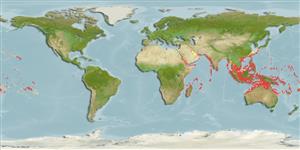Preferred temperature (Ref.
115969): 23.8 - 28.4, mean 27.4 (based on 397 cells).
Phylogenetic diversity index (Ref.
82804): PD
50 = 0.5000 [Uniqueness, from 0.5 = low to 2.0 = high].
Bayesian length-weight: a=0.00457 (0.00244 - 0.00856), b=3.04 (2.89 - 3.19), in cm Total Length, based on LWR estimates for this species & Genus-body shape (Ref.
93245).
Trophic level (Ref.
69278): 3.9 ±0.4 se; based on diet studies.
устойчивость к внешним воздействиям (Ref.
120179): низкий, минимальное время удвоения популяции 4.5-14 лет (Fec=2).
Prior r = 0.26, 95% CL = 0.17 - 0.39, Based on 3 data-limited stock assessments.
Fishing Vulnerability (Ref.
59153): High vulnerability (57 of 100).
